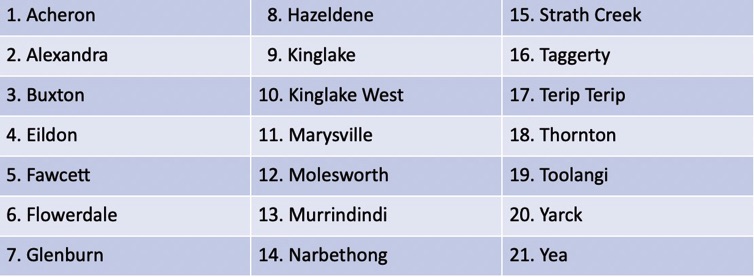SENSE (Solar Energy Nodes for Secured Electicity)
Climate Change is posing threats in many dimensions, and this has been recognised in “Victoria’s Climate Change Strategy” released in May 2021, wherein the State Government pledges a 45-50% reduction in net emissions by 2030 and net-zero emissions by 2050. To achieve this “will require action across all sectors of the economy by governments, businesses and the community”, in both reducing emissions at the source and offsetting any remaining source emissions.
The Murrindindi Climate Network (MCN) have therefore developed proposals which address both these issues, whereby Murrindindi Shire, and other stakeholders, could become partners in projects that reduce source emissions and create emissions offsets. The first objective is targeted by a project (described below) called Solar Energy Nodes for Secured Electricity (SENSE) while the second is addressed by an expansion of farm forestry plantations to sequester carbon dioxide (described separately).
The basic concept of SENSE would be to install solar panels and battery installations in public places (such as halls and other appropriate facilities) that could serve as bases for expansion to renewable energy hubs for their townships as time progresses. These installations would house mini-solar-farms (on rooftops or on-ground) and community batteries to serve the needs of the installation itself and to share excess energy with neighbouring households, businesses and community facilities. With this energy sharing in mind, discussions have commenced with Enosi Energy to implement their Powertracer system in conjunction with local community energy retailers Energy Locals, and perhaps Indigo Power, in order to create virtual MicroGrids for the townships.
Powertracer uses software to analyse smart-meter data from each participating property, one day in arrears, and matches the electricity offered for sale within each 30-minute period (the “supply”) with the electricity wanting to the bought (the “demand”) in that same period. Buyers and sellers are then matched so that they can share electricity at mutually agreeable prices. After all matches are done for that period, any surplus “supply” is sold to the grid at market price, or any surplus “demand” is bought from the grid at market price. Powertracer offers the possibility of connecting the SENSE installation with a group of surrounding properties, so that they can trade electricity between each other at mutually agreeable prices with a Virtual MicroGrid. Importantly, such Virtual MicroGrids require no additional hardware beyond the solar panels and batteries that the properties currently possess. Although the financial benefits may be small at the moment, such Virtual Microgrids offer significant savings to local energy sharing schemes in the future, if electricity distributors adopt distance-based distribution charges, like most other infrastructure networks.
A secondary benefit of the SENSE installations would be realised during extreme events, such as power blackouts, storms and fires, if the SENSE installation had the ability to isolate from the national grid, and operate as a stand-alone energy centre, serving the SENSE installation itself and perhaps some very adjacent external properties. Such SENSE installations would not be intended to serve the role of CFA Community Fire Refuges, where residents seek a refuge of last resort during bushfires. Rather they would be in nearby towns that are not directly impacted by the fire-front, much as the Alexandra sports centre served as a place of assembly for the provision of services for residents of Marysville, Buxton and Taggerty during the 2009 bushfires.
MCN have identified 21 townships around the Shire, which might be candidate SENSE locations, but these will need to be prioritised according to available funding. They are:
There is redundancy built into this list, so that if one location is incapacitated during an extreme event, other surrounding towns can serve as backup locations. Clearly, there is scope for some negotiation as to which towns should or should not be on this list. Some towns may already have some solar facilities, while others are starting from scratch.
A major issue is to ensure that installations are appropriately scaled. Solar generation and battery storage must be sufficient to ensure that the SENSE location can continue to operate effectively during an extended extreme event situation, with the energy demands expected under such conditions. While standby generators can supplement the required energy generation, solar and battery sizing to provide coverage for overnight and cloudy/smoky day conditions will be essential.
Some of these 21 sites will have single-phase electricity supplies, while others will have three-phase supplies. Preliminary costing estimates indicate about $75,000/location for those sites with single-phase electricity, $135,000/location for a medium-sized 3-phase installation and $250,000/location for a large-scale 3-phase installation. If there was an even split among these three types of installation, the total project capital cost would be approximately $3.2million for the entire 21 townships.

